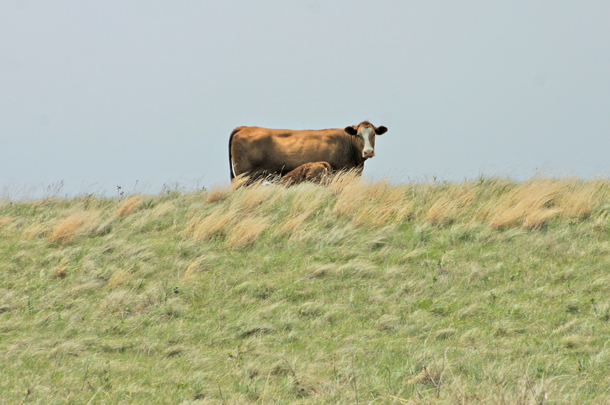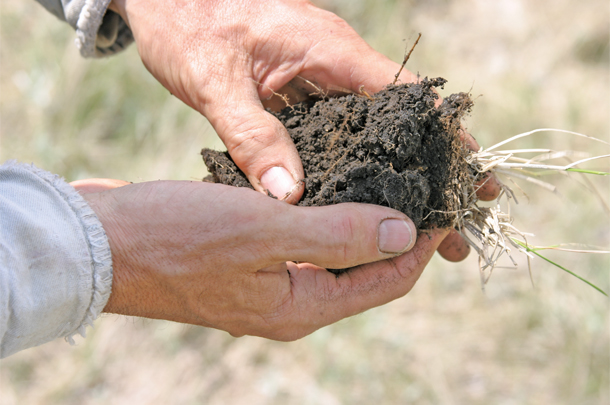Rotational grazing isn’t a new idea. Nor is the idea of managing native rangelands and the ruminants that graze them in the vein of how the American bison grazed the landscape.
Putting those two together into one management plan, however, is a lot harder than you might think, says Jay Fuhrer. He’s a long-time conservationist with the USDA’s Natural Resources Conservation Service (NRCS), based in Bismarck, North Dakota.
Over his 40-plus years with NRCS, helping ranchers and farmers build soil health, his thinking and approach to rangeland management changed considerably. It wasn’t that his classic training in rangeland management was wrong, he says. It was just incomplete.
Take rotational grazing. He’s been advocating that since day one. Over time, however, he saw that rangeland soil health first plateaued, then began to slip. And if the soil ain’t very healthy, ain’t nothing very healthy.
Thus began his secondary career of head scratching, systems thinking and looking at history.
 Jay Fuhrer (left), retired NRCS soil specialist, and Todd McPeak are not just good friends but partners in bringing the McPeak Ranch soil profile back to a healthy state. Photo by Burt Rutherford.
Jay Fuhrer (left), retired NRCS soil specialist, and Todd McPeak are not just good friends but partners in bringing the McPeak Ranch soil profile back to a healthy state. Photo by Burt Rutherford.Looking back to look ahead
Fuhrer has traveled the world consulting and advocating for soil health. The Northern Plains, however, are his home turf. To look ahead, then, he says you first have to look back. “So in the Northern Plains, if we look at that scenario for a rancher, when was the last time a glacier came through?”
The answer is roughly 11,000 years ago when the last glacier receded. That’s important in understanding what happened after. Over time, the ecosystem developed with a high diversity of plants and a diversity of animals, dominated by large ruminants, he says. “And so we begin to understand that this is how our mollisols soils were built.”
Fast-forward to the 1870s and the short period of the buffalo hunters. For an honest look at what happened, Fuhrer recommends The Buffalo Harvest, a book by Frank Mayer, a buffalo hunter who reported what he did and witnessed.
The bison were essentially eradicated by 1878. During and after the buffalo harvest, the wolfers came in and removed the wolves, coyotes and other predators. Then came the bone collectors, who shipped the bison bones east to be made into a variety of products.
“And then came the big cattle drives,” Fuhrer says. “So you’re looking at this transformation where we took out an established ecosystem.”
From a rancher’s perspective, understanding the High Plains ecosystem prior to 1870 is to understand what built prairie soils into the finest subterranean ecosystem in the world. Continuing that train of thought, Fuhrer started thinking about how to build those soils back to what their original health might have been.
Understanding is important. That’s the first part. Implementation, well, that’s where hooves hit the ground and management becomes key. And that’s where Frank Mayer gives some important clues.
“He explained how the buffalo were in small groups and that the matriarch ran the show,” Fuhrer says. More importantly to modern range management, these small groups of 15 to 25 or so probably never grazed the same place twice, at least not in the same year or at the same time of year.
Circling back to rotational grazing
The first grazing systems Fuhrer set up were classic rotational grazing. Cattle would rotate through each pasture, grazing it once. “Or we could go with a twice-over and think, ‘OK, we got ’er.’” But as he gained more experience and worked more with the Northern Plains ecosystem, he came to realize that no, he and the ranchers he worked with didn’t have it yet. At least not all of it.
“When you keep repeating a known process, whether it’s a cropping system or a grazing system, the soil biology reaches a static level because the amount of food coming in is pretty much the same and maybe coming in at the same time every year,” he says.
 When touring most ranches, you see the best pasture on the place – not on the McPeak Ranch. This is what Todd McPeak says is his worst pasture. In a drought, pastures managed with soil health as a primary goal become great drought insurance. Photo by Burt Rutherford.
When touring most ranches, you see the best pasture on the place – not on the McPeak Ranch. This is what Todd McPeak says is his worst pasture. In a drought, pastures managed with soil health as a primary goal become great drought insurance. Photo by Burt Rutherford.
For soil microbes, carbon is food. But if a pasture is grazed at the same time every year, for the same length of time every year, the soil food web stops flourishing because it isn’t getting its full RDA of carbon, Fuhrer says.
“So what I evolved into eventually is, maybe we’re going to start out with a once-over, we’re maybe going to go to a twice-over, but we need to monitor breedback. Because if you’re in a ranch setting and you aren’t maintaining conception rates, you’re not there for the long term. We’ve got to have that in order to make everything else work,” he says.
“And if your conception rates are suffering, then we’re probably going to take a look at coming in with a twice-over system,” he says. That’s a more intensive system that will keep grasses in a higher plane of nutrition rather than letting them mature into a higher carbon level. “We would harvest them at an earlier time, but it’d be a light harvest. And we could come back again later to repeat that process.”
Into that system, he looks at where the herd is reproductively. “Where’s your herd going to be when they’re exposed to the bulls, and where were they 30, 45 days or so before that bull? And I want to see that they’re on the high plane in nutrition.”
That’s especially important for second-calf heifers, he says. That’s because they need a little more TLC and the twice-over system keeps plants in a high-protein, low-carbon state.
And that’s where soil health becomes critical, says Ashley Kettner, R&D research coordinator for Rio Nutrition and a sixth-generation rancher with her husband. The soil food web enables the microorganisms to more effectively provide nutrients to the plants.
“When the plant is able to not just access more nutrients but then uptake more nutrients, that’s going to build resilience against drought and disease,” she says. “It’s going to help make sure that plant is more nutrient-dense.” And the cattle then get more good out of every bite.
Some pastures won’t be grazed until the plants are mature. That’s a great place for mature cows because they don’t need as high a plane of nutrition as a lactating heifer that’s also growing a calf inside.
Then Fuhrer would identify pastures he would ask ranchers to graze down very hard. “Maybe once every six, seven years or even 10 years. Because the buffalo would have done it.”
Beyond that, he says the buffalo likely would graze green plants earlier in the spring and later in the fall and into the winter. And their grazing pattern would have been random and unpredictable. “And so you had a whole different scenario than a classic rotational grazing system, plus you would have had many more heads,” he says.
“So I started to realize how understocked we were. And I started to increase the numbers and decrease the time. And started to become a bit more unpredictable in setting up the grazing pattern for the year.”
From a soil health standpoint, what happens is: Hoof action tramples the high-protein, low-carbon plants onto the soil surface. That, combined with manure and urine, becomes food that’s immediately available to the soil microorganisms.
In pastures with mature plants when cattle are turned in, hoof action puts those higher-carbon plants on the soil surface. “Now I’ve got something for the mycorrhizal fungi to work on,” he says. “We have the higher-carbon material to decompose on the soil surface, and it takes mycorrhizal fungi to do that. They break the carbon down into simpler chains and then the bacteria come in and clean things up.”
Over time, that puts more organic matter into the soil, Kettner says. That enables the soil to capture and retain more water from rain and snow, among other things.
“We can’t hope to ever totally match what nature did,” Fuhrer says, “but we can mimic it. We can impact the dynamic soil properties with management. And that’s what soil health is based on. You’re impacting the dynamic soil properties with your management.”
When you’re managing with intent, you’re managing much like the range ecosystem developed. And your soils, plants and cattle will flourish.

Todd McPeak holds a handful of the kind of soil he likes to see and smell. The black color tells him it’s got plenty of carbon, which feeds the soil food web and, ultimately, his hay crop and plants in his pastures. Photo by Burt Rutherford.
Building soil health on tame pastures
“I like tame pastures because they complement native rangeland so well,” says Jay Fuhrer, retired conservationist and soil health specialist with the Natural Resources Conservation Service in Bismarck, North Dakota. “Tame pastures can enhance the native rangeland because it gives you another grazing option.”
Fuhrer likes a diversity of plant species in the mix. If he can get seven or eight different species, “I think the livestock do so much better because there are different plants meeting different needs.”
But soil health can suffer on tame pastures if not managed well. The key to building soil health, he says, is how many of the plants are trampled into the soil surface.
That’s important because those plants will decompose into organic matter and carbon. Organic matter builds the soil profile to better retain moisture. Carbon along with manure and urine becomes food for the soil microorganisms.
To determine how much to graze and how much to leave, he clips some of the more dominant plants at ground level. Then he extends his hand like he’s offering a handshake and lays the plants across the top of his hand and finds the balance point.
“Now I know where 50 percent is. And I know I can take at least that.” If the pasture has been lightly grazed, the cattle can take a little more. “But you have to understand that the farther down you go on the plant, the lower the protein and energy.”
If you’re grazing first- or second-calf heifers, you want to graze lightly so the cattle get the most nutrients the plant has to offer. “But if you’ve got some old, dry cows, you’re not taking too much of a chance there. The older cows can get really good gains, and I can take more of the plant.”
The key, he says, is to constantly change up the grazing system. “Because that’s what the buffalo did.” And the soil evolved with a high plant diversity and the unpredictable and constantly changing grazing pattern of the buffalo.












